Defective dystrophic thymus determines degenerative changes in skeletal muscle
- PMID: 33833239
- PMCID: PMC8032677
- DOI: 10.1038/s41467-021-22305-x
Defective dystrophic thymus determines degenerative changes in skeletal muscle
Abstract
In Duchenne muscular dystrophy (DMD), sarcolemma fragility and myofiber necrosis produce cellular debris that attract inflammatory cells. Macrophages and T-lymphocytes infiltrate muscles in response to damage-associated molecular pattern signalling and the release of TNF-α, TGF-β and interleukins prevent skeletal muscle improvement from the inflammation. This immunological scenario was extended by the discovery of a specific response to muscle antigens and a role for regulatory T cells (Tregs) in muscle regeneration. Normally, autoimmunity is avoided by autoreactive T-lymphocyte deletion within thymus, while in the periphery Tregs monitor effector T-cells escaping from central regulatory control. Here, we report impairment of thymus architecture of mdx mice together with decreased expression of ghrelin, autophagy dysfunction and AIRE down-regulation. Transplantation of dystrophic thymus in recipient nude mice determine the up-regulation of inflammatory/fibrotic markers, marked metabolic breakdown that leads to muscle atrophy and loss of force. These results indicate that involution of dystrophic thymus exacerbates muscular dystrophy by altering central immune tolerance.
Conflict of interest statement
The authors declare no competing interests.
Figures
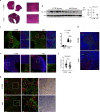
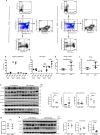
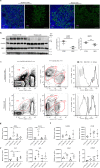

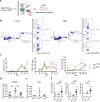

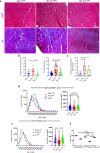

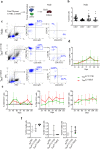

Similar articles
-
Regulatory T cells suppress muscle inflammation and injury in muscular dystrophy.Sci Transl Med. 2014 Oct 15;6(258):258ra142. doi: 10.1126/scitranslmed.3009925. Sci Transl Med. 2014. PMID: 25320234 Free PMC article.
-
Alterations in Notch signalling in skeletal muscles from mdx and dko dystrophic mice and patients with Duchenne muscular dystrophy.Exp Physiol. 2014 Apr;99(4):675-87. doi: 10.1113/expphysiol.2013.077255. Epub 2014 Jan 17. Exp Physiol. 2014. PMID: 24443351
-
T and B lymphocyte depletion has a marked effect on the fibrosis of dystrophic skeletal muscles in the scid/mdx mouse.J Pathol. 2007 Oct;213(2):229-38. doi: 10.1002/path.2213. J Pathol. 2007. PMID: 17668421
-
The Immune System in Duchenne Muscular Dystrophy Pathogenesis.Biomedicines. 2021 Oct 11;9(10):1447. doi: 10.3390/biomedicines9101447. Biomedicines. 2021. PMID: 34680564 Free PMC article. Review.
-
The companions: regulatory T cells and gene therapy.Immunology. 2009 May;127(1):1-7. doi: 10.1111/j.1365-2567.2009.03069.x. Immunology. 2009. PMID: 19368560 Free PMC article. Review.
Cited by
-
Primary mouse myoblast metabotropic purinoceptor profiles and calcium signalling differ with their muscle origin and are altered in mdx dystrophinopathy.Sci Rep. 2023 Jun 8;13(1):9333. doi: 10.1038/s41598-023-36545-y. Sci Rep. 2023. PMID: 37291185 Free PMC article.
-
Immunoproteasome Inhibition Ameliorates Aged Dystrophic Mouse Muscle Environment.Int J Mol Sci. 2022 Nov 24;23(23):14657. doi: 10.3390/ijms232314657. Int J Mol Sci. 2022. PMID: 36498987 Free PMC article.
-
Transplantation of Differentiated Tonsil-Derived Mesenchymal Stem Cells Ameliorates Murine Duchenne Muscular Dystrophy via Autophagy Activation.Tissue Eng Regen Med. 2022 Dec;19(6):1283-1294. doi: 10.1007/s13770-022-00489-7. Epub 2022 Nov 1. Tissue Eng Regen Med. 2022. PMID: 36318366 Free PMC article.
-
Development of Therapeutic RNA Manipulation for Muscular Dystrophy.Front Genome Ed. 2022 May 10;4:863651. doi: 10.3389/fgeed.2022.863651. eCollection 2022. Front Genome Ed. 2022. PMID: 35620642 Free PMC article. Review.
-
Gintonin-enriched fraction improves sarcopenia by maintaining immune homeostasis in 20- to 24-month-old C57BL/6J mice.J Ginseng Res. 2021 Nov;45(6):744-753. doi: 10.1016/j.jgr.2021.07.006. Epub 2021 Jul 23. J Ginseng Res. 2021. PMID: 34764729 Free PMC article.
References
Publication types
MeSH terms
Substances
LinkOut - more resources
Full Text Sources
Other Literature Sources
Molecular Biology Databases

